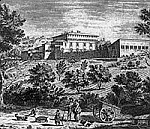| Comune: | Firenze |
| Località: | Careggi |
| Viale: | Gaetano Pieraccini, 17 |
 Acquistata dalla famiglia Medici nel 1417, alla morte di Giovanni di Bicci dei Medici la villa venne ereditata dal figlio Cosimo il Vecchio che incaricò Michelozzo di ristrutturarla. L'intervento fu decisamente consistente ed ebbe come centro generatore il cortile loggiato caratterizzato dalla sua forma trapezoidale. A Michelozzo si deve anche l'apertura delle logge, ai piani superiori, che resero l'edificio più aperto verso il giardino e il paesaggio circostante. Dopo la morte di Cosimo il Vecchio, avvenuta proprio a Careggi nel 1464, seguita cinque anni dopo da quella del figlio, fu il nipote Lorenzo il Magnifico a diventare il capo della famiglia Medici. Qui Lorenzo si riuniva con i suoi amici membri dell'Accademia Platonica ed è qui che passo gli ultimi anni della sua vita fino al 1492, anno della sua morte. Del giardino al tempo di Lorenzo rimangono alcune descrizioni che parlano di una vegetazione composta da mirti, olivi, querce, pioppi, pini, platani, piante di agrumi, spezie, mirra e incenso. Tale descrizione fa pensare ad un giardino articolato in due parti, una coltivata a fiori e frutta ed un'altra che costituiva il selvatico. Con la morte di Lorenzo il Magnifico, inizia un periodo di decadenza della villa interrotto dal cardinale Carlo che dopo il 1615 intraprese un ampio progetto di trasformazione degli interni e del giardino. Passata alla casa Lorena dopo che questi succedettero nel Granducato ai Medici, la proprietà venne venduta nel 1779 a Vincenzo Orsi. La famiglia Orsi nel 1848 la rivendette al ricco inglese Francis Sloane, geologo e studioso di scienze naturali. A Sloane si devono gli interventi di trasformazione del giardino con la creazione del parco "romantico", nel quale utilizzò molte specie arboree esotiche tuttora esistenti (cedri del Libano e dell'Himalaya, sequoie della California , corbezzoli di Grecia, palme), e la costruzione di una limonaia dove si trovavano, una preziosa collezione di agrumi, e molte varietà di palme. Dopo la morte di Sloane, la villa cambiò più volte proprietà, fino al definitivo acquisto da parte dell'Arcispedale di Santa Maria Nuova nel 1936.
Acquistata dalla famiglia Medici nel 1417, alla morte di Giovanni di Bicci dei Medici la villa venne ereditata dal figlio Cosimo il Vecchio che incaricò Michelozzo di ristrutturarla. L'intervento fu decisamente consistente ed ebbe come centro generatore il cortile loggiato caratterizzato dalla sua forma trapezoidale. A Michelozzo si deve anche l'apertura delle logge, ai piani superiori, che resero l'edificio più aperto verso il giardino e il paesaggio circostante. Dopo la morte di Cosimo il Vecchio, avvenuta proprio a Careggi nel 1464, seguita cinque anni dopo da quella del figlio, fu il nipote Lorenzo il Magnifico a diventare il capo della famiglia Medici. Qui Lorenzo si riuniva con i suoi amici membri dell'Accademia Platonica ed è qui che passo gli ultimi anni della sua vita fino al 1492, anno della sua morte. Del giardino al tempo di Lorenzo rimangono alcune descrizioni che parlano di una vegetazione composta da mirti, olivi, querce, pioppi, pini, platani, piante di agrumi, spezie, mirra e incenso. Tale descrizione fa pensare ad un giardino articolato in due parti, una coltivata a fiori e frutta ed un'altra che costituiva il selvatico. Con la morte di Lorenzo il Magnifico, inizia un periodo di decadenza della villa interrotto dal cardinale Carlo che dopo il 1615 intraprese un ampio progetto di trasformazione degli interni e del giardino. Passata alla casa Lorena dopo che questi succedettero nel Granducato ai Medici, la proprietà venne venduta nel 1779 a Vincenzo Orsi. La famiglia Orsi nel 1848 la rivendette al ricco inglese Francis Sloane, geologo e studioso di scienze naturali. A Sloane si devono gli interventi di trasformazione del giardino con la creazione del parco "romantico", nel quale utilizzò molte specie arboree esotiche tuttora esistenti (cedri del Libano e dell'Himalaya, sequoie della California , corbezzoli di Grecia, palme), e la costruzione di una limonaia dove si trovavano, una preziosa collezione di agrumi, e molte varietà di palme. Dopo la morte di Sloane, la villa cambiò più volte proprietà, fino al definitivo acquisto da parte dell'Arcispedale di Santa Maria Nuova nel 1936.
 Bought by the Medici family in 1417, the villa was inherited following the death of Giovanni di Bicci dei Medici by his son Cosimo the Elder, who commissioned Michelozzo to renovate the property. A great deal of work was done, the focus of attention being the characteristically trapezoid court, with loggias. Michelozzo also created the loggias on the upper floors, opening the building up to the garden and the surrounding countryside. When Cosimo the Elder died, at Careggi itself in 1464, and his son followed him to the grave just five years later, the nephew Lorenzo il Magnifico became the head of the Medici family. It was to this villa that Lorenzo brought his friends, members of the Plato Academy, and here that he spent the last years of his life, until his own death in 1492. Surviving descriptions of the garden as it was in the time of Lorenzo speak of vegetation composed of myrtles, olives, oaks, poplars, pines, plane trees, citrus trees and such exotic spices as frankincense and myrrh. The description suggests that the garden was in two parts, one for the cultivation of flowers and fruit and another "wilder" part. After Lorenzo il Magnifico's death, the villa gradually began to fall into a state of disrepair, a decline that was halted by cardinal Carlo who, after 1615, undertook extensive projects to transform the interior and the garden. Having passed into the hands of the Lorraine household, when they came to power in the Grand-Duchy following the demise of the Medici dynasty, the property was bought in 1779 by Vincenzo Orsi. The Orsi family in turn sold the estate to English geologist and natural history scholar Francis Sloane, in 1848. It was Sloane who transformed the garden into a "romantic" park, introducing many exotic trees, many of which still stand (Lebanon and Himalayan cedars, Californian sequoias, Greek arbutus and palms), and constructed an orangery with a valuable collection of citrus fruits and many varieties of palm tree. After Sloane's death the property changed hands several times, and was eventually bought by a hospital, the Arcispedale di Santa Maria Nuova, in 1936.
Bought by the Medici family in 1417, the villa was inherited following the death of Giovanni di Bicci dei Medici by his son Cosimo the Elder, who commissioned Michelozzo to renovate the property. A great deal of work was done, the focus of attention being the characteristically trapezoid court, with loggias. Michelozzo also created the loggias on the upper floors, opening the building up to the garden and the surrounding countryside. When Cosimo the Elder died, at Careggi itself in 1464, and his son followed him to the grave just five years later, the nephew Lorenzo il Magnifico became the head of the Medici family. It was to this villa that Lorenzo brought his friends, members of the Plato Academy, and here that he spent the last years of his life, until his own death in 1492. Surviving descriptions of the garden as it was in the time of Lorenzo speak of vegetation composed of myrtles, olives, oaks, poplars, pines, plane trees, citrus trees and such exotic spices as frankincense and myrrh. The description suggests that the garden was in two parts, one for the cultivation of flowers and fruit and another "wilder" part. After Lorenzo il Magnifico's death, the villa gradually began to fall into a state of disrepair, a decline that was halted by cardinal Carlo who, after 1615, undertook extensive projects to transform the interior and the garden. Having passed into the hands of the Lorraine household, when they came to power in the Grand-Duchy following the demise of the Medici dynasty, the property was bought in 1779 by Vincenzo Orsi. The Orsi family in turn sold the estate to English geologist and natural history scholar Francis Sloane, in 1848. It was Sloane who transformed the garden into a "romantic" park, introducing many exotic trees, many of which still stand (Lebanon and Himalayan cedars, Californian sequoias, Greek arbutus and palms), and constructed an orangery with a valuable collection of citrus fruits and many varieties of palm tree. After Sloane's death the property changed hands several times, and was eventually bought by a hospital, the Arcispedale di Santa Maria Nuova, in 1936.

